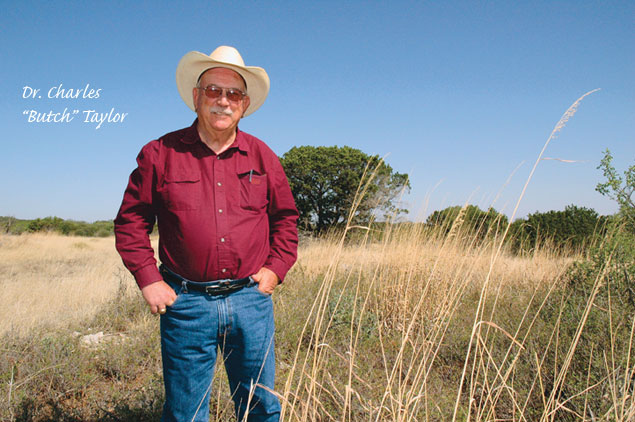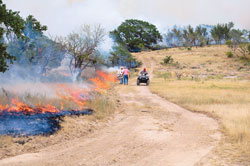
Dr. Charles Taylor
Photo by Sheryl Smith-Rodgers
The dusty drive along Cusenbary Road takes only 15 minutes or so, but it’s long enough to impress visitors, who come looking for a better way to manage their land.
Dr. Charles “Butch” Taylor has given the stop-and-go tour countless times. On every trip, though, a new passenger gazes out the window and watches in amazement as scrubby landscapes densely splotched with junipers gradually give way to thick, wavy stands of native grasses.
“I start ranchers at one end of the road and by the other end, they’re ready to be pyromaniacs,” says Taylor, who oversees the Texas AgriLife Research Station south of Sonora, Texas. “They take one look at the last field and say, ‘That’s what I want! How do I get it?’ This short drive tells a convincing story that fire equals more grass.”
Historically, wildfires across the grassy savannahs of the Great Plains suppressed the growth of woody and noxious plants. Native Americans who understood the role of fire scorched the land to bring back tender grasses and draw wild game.
“In the last century, the grassy savannahs have shifted to solid stands of cedar,” Taylor says. “That’s happened because too much livestock largely fireproofed the plains by grazing away the fuel — our native grasses. We’ve got to restore a proper balance again between woody plants and grasses.”
For many years, Taylor has advocated prescribed burns as a cost-effective, efficient management tool for revitalizing rangeland health. In 1997, he helped 35 ranchers establish the Edwards Plateau Prescribed Burning Association (EPPBA), the first of its kind in Texas. Today, the organization has more than 300 members in 20 counties. Inspired by its success, eight more prescribed burning associations across the state — representing 859 members and 105 counties — have since organized.
The Army Shows the Way
While serving in the U.S. Army, Taylor often observed fire and its effects on a landscape. “In 1968, while at Fort Sill in Oklahoma, we were firing rounds into an impact zone, and a fire started,” he recalls. “When I asked, the colonel told me that they had fires every year. What I noticed were the beautiful grasslands that came afterward.”

Workers initiate a prescribed burn in the Edwards Plateau region.
Photo Courtesy of AgriLife Research – Sonora
Homeowner Precautions
Wildfires across Texas killed 19 people and scorched 2.2 million acres in 2005 and 2006, according to the Texas Forest Service. The blazes also destroyed 734 homes.
“That’s an incredible amount of loss,” Dr. Charles Taylor says. “You’d think we would have learned a lesson, but we haven’t. We’ve got to teach people how to fireproof their own residences, and that’s something that must get started a year in advance. Because when a fire starts, it’s too late!”
To lessen the danger of wildfires, Taylor advocates what he calls “fuel management.”
“People buy land for homes and recreation, not livestock,” he explains. “So grass doesn’t get grazed. It turns dry and becomes fuel for intense wildfires. Prescribed burns help to manage fuels and reduce the intensity of wildfires.”
Homeowners can follow these tips to protect their property against wildfires:
- Remove dry vegetation and volatile fuels near a home. Dry junipers are like cans of kerosene.
- Keep grass that grows around a home short and preferably green (watered).
- Underpin wooden decks attached to a home with hail screen or other nonflammable material to help prevent leaves and other plant material from accumulating underneath. “Leaves can blow under them,” Taylor says. “Once an ember lands on the leaves or deck, a fire can start.”
- Don’t attach wooden gates and/or wooden fences to a home.
- Avoid wooden shingles; use tin or metal to roof a home. Use rock or brick or nonflammable siding.
- Install small screens around attic vents, crawl spaces and soffits to block embers.
- Double-paned windows offer more protection than single-pane units.
- Landscape your property to create defensible space between your home and the surrounding environment.
For more information and safety tips, visit www.firewise.org.
At Fort Hood in Texas and later in Vietnam, the same scenario unfolded: Hot summer fires led to lush fall grasses. “It didn’t take a rocket scientist to put all that together,” Taylor says.
In 1972, he began working (and living) at the Sonora Experiment Station as a technician. More experience and a doctorate degree led him up the ladder to research associate, research scientist and, finally, superintendent and professor.
“My wife and I raised three sons here,” Taylor adds. “Five years ago, she decided we needed our own home. So we bought some land and a house northeast of Sonora. We got our loan with Capital Farm Credit. They’ve been nothing but pleasant to deal with. Folks there are very friendly and helpful. They explain everything with no hassles or pressure.”
Overcoming Fears
Wanting to document results, Taylor set his first summer fire at the experiment station in 1987. The burn killed off more than 95 percent of abundant prickly pear. Pleased and proud, Taylor showed the pasture to his supervisor. His response: “Do your burns where the public can’t see them.””
Sure enough, the charred ground alarmed local residents. “Who was foolish enough to let that happen?” they’d ask Taylor. “I’m not sure,” he’d reply, “but if we ever find out, he’ll be in trouble!”
Still, Taylor continued his prescribed burns at the station. In the mid 1990s, he also pondered a grassroots initiative first started in California: prescribed fire associations, a partnership of like-minded landowners who pool their expertise and equipment.
“At that time, ranchers in Texas were afraid of the liability involved with fires,” Taylor says. “They didn’t know how to safely use fire nor did they have the equipment. Most of them were waiting for agencies like us to do burns.”
Landowners Blend Together
At a field day in October 1997, Taylor and his staff drove ranchers past the demonstration pastures on Cusenbary Road. They also discussed how vegetation responded to different burn frequencies. Afterward, Taylor proposed that landowners establish their own burn association. By day’s end, 35 members of the new Edwards Plateau Prescribed Burning Association had elected officers and approved guidelines.
Within a year, the membership had grown to more than 60. Since its founding, the EPPBA has successfully conducted more than 1,000 prescribed burns on approximately 500,000 acres. For their efforts, members received a 2010 Lone Star Land Steward Award from the Texas Parks and Wildlife Department.
Forming the cooperative has paid off financially for both the group and individuals. The registered nonprofit association has received more than $60,000 in grants and donated equipment, such as a fire truck, which is available at no charge to members.
As a brush control measure, burning is less costly than removing juniper mechanically, according to Taylor. “The mechanical removal of juniper runs $100 an acre,” he says. “Production income from this land is not high enough to pay those costs. But prescribed burns cost only 50 cents to $10 an acre.”
Using Fire to Prevent Bigger Fires
In nearby Edwards County, Souli Shanklin, a charter member of the EPPBA, reports that his grandfather and great-grandfather routinely used fire as a range management tool.
“My family and I want to be least-cost producers,” says Shanklin, who ranches and presides as county judge in Rocksprings. “That is, we want to ranch like they did before the feedlot industry and grow the feed ourselves. Prescribed burns are helping us achieve that goal.”
Neighborly Co-op
In Schleicher County, Cades Pope — also a customer with Capital Farm Credit in Sonora — manages his family land for cattle and deer. Like many other folks, he shunned controlled burns. “Then I saw what ranchers with the burn association were accomplishing,” Pope says. “I joined in 2004 and had our first burn the next year. We knocked out 95 percent of the prickly pear after we followed up with an aerial spray.”
“Prescribed burns are phenomenal tools,” adds Pope, a past president of EPPBA. “But they require a lot of manpower. With the burn association, we know we can count on a core group of people to help.”
Neighbors helping neighbors — that’s the basic tenet of any successful cooperative. “We also empower and equip landowners,” Taylor stresses. “We provide training, experience and equipment. The only cost is $35 a year, and all we ask in return is that members help with other members’ burns.”
Three-day burn schools (basic and advanced) are held at the Sonora station in February, March and August. The registration fee is $395 per session.
“Once landowners are trained, they gain confidence,” Taylor says. “Then that empowers them within the community and helps them overcome other people’s fear of fire.”
The key, he maintains, is learning to use fire safely.
“Smokey the Bear was one of our most effective ad campaigns ever,” Taylor adds. “Unfortunately, he turned Americans completely against fire. It’s time to change that paradigm and turn fire suppression into fire management.”
Can You Burn in a Drought?
In Texas, most counties implement burn bans during drought conditions. A ban prevents the implementation of prescribed fire unless the burner obtains an exemption from the county judge. Exceptions are made for certified prescribed burn managers.*
However, “burning under drought conditions is a common practice,” says Dr. Charles Taylor, “and as long as one is cautious and prudent, this should be considered an acceptable practice.”
*Certified prescribed burn managers are trained and licensed through the Texas Department of Agriculture. They must carry at least $1 million in liability insurance.
Prescribed Burn Basics
Prep Work
Staging a prescribed burn takes at least one year or more of advanced preparations. Here’s a brief rundown of what’s involved:
Goals and Objectives
What do you want to achieve? Reduce prickly pear? Improve deer habitat? Your “prescription” must be clearly thought out and written down.
Courtesy of AgriLife Research – Sonora
A team of volunteers carefully monitors the fire and weather conditions.
Burn Plan
You must complete a worksheet from your government agency that regulates prescribed burns. On the burn plan, you must list fuel and weather conditions, personnel and equipment needed, and other pertinent information. Modifications can be made as the target date nears. A fire-weather forecast must be filed up to five days in advance, and followed by continual weather-monitoring.
Fireguards
A fireproof perimeter must be established to prevent a burn from spreading. Existing roads may serve as fireguards. Other options include disking or plowing a plowed row and wetting a fire line.
Burn Day
You’ll require plenty of personnel to stage a successful burn.
- Burn boss — This experienced individual prepares for, oversees and takes responsibility for the prescribed burn.
- Drip torch crew — Responsible for igniting the fuel.
- Weather reporter — Constantly monitors wind speeds and directions, temperature and relative humidity.
- Fire suppression crew — Patrols the fire’s outer perimeter and extinguishes spot fires.
- Other — Extra workers ready to relieve other personnel as needed.
To learn more about the EPPBA and other prescribed burning associations, visit http://pfire.tamu.edu.
The following state agencies are responsible for regulating prescribed burns in their respective states: Alabama Forestry Commission, Louisiana Department of Agriculture and Forestry, Mississippi Forestry Commission, and Texas Department of Agriculture. In New Mexico, two agencies regulate prescribed burns: the New Mexico Air Quality Bureau and New Mexico Forestry.